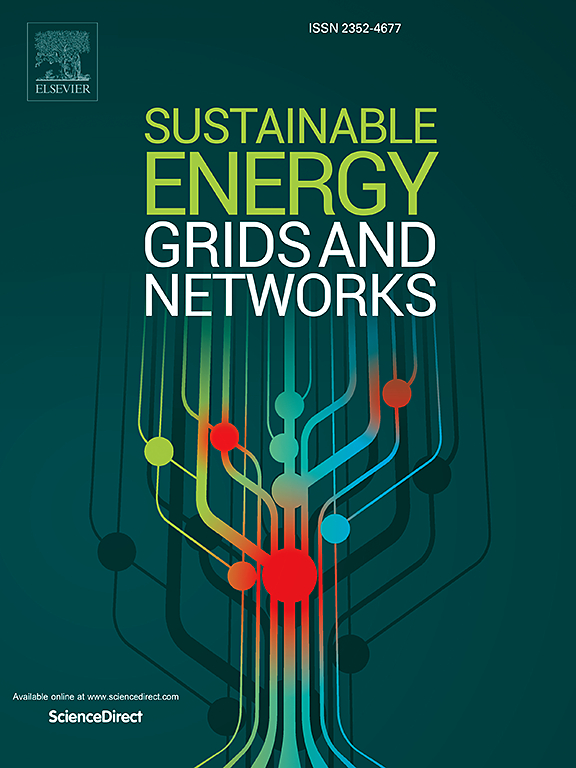电力系统拓扑概述和进展,解决异常运行条件下的事前和事后策略问题
IF 4.8
2区 工程技术
Q2 ENERGY & FUELS
引用次数: 0
摘要
随着可再生能源和电动汽车(EV)利用率的不断提高,以及其他各种电气设备使用量的不断增加,对电力系统(EPS)的稳定和弹性运行提出了挑战,尤其是在面对与气候变化相关的自然现象时。这意味着,准确的拓扑结构和平衡的 EPS 对提高快速、协调地应对网络攻击、地震和洪水等灾害情况的能力起着关键作用。本研究提出了一种新方法,用于快速、准确地检测 EPS 中的拓扑攻击,从而提高其安全性和弹性。所提出的方法通过事后和事前的运营策略对 EPS 进行管理,为维持不间断的电力服务提供了见解。这种方法通过利用获得的拓扑信息识别故障点并创建微电网(MG)组来实现。机器学习技术已被集成到数据入侵攻击检测(DIAD)系统中,从而能够检测出被操纵或有故障的智能电表(SM)。同时,还提出了一种基于拓扑识别(TI)的图学习算法,以确定事件发生前后的确切故障位置。在确定 TI 区域后,为恢复中压区域,采用了混合整数线性规划 (MILP) 方法来优化中压区域的负荷恢复过程。该方法旨在利用灵活的应急电力平衡系统,包括电网支持储能系统 (GSS)、光伏系统 (PV)、电动汽车充电站 (EVCS) 和移动发电机,最大限度地减少损失,并尽快将关键负载恢复到先前状态。此外,还就 EPS 拓扑、相位识别 (PI) 及其对电力系统恢复能力 (PSR) 的影响等主题进行了详细汇编,为 EPS 的未来发展提供了启示。本文章由计算机程序翻译,如有差异,请以英文原文为准。
Overview and advancement of power system topology addressing pre- and post-event strategies under abnormal operating conditions
The transition towards increased utilization of renewable energy and electric vehicles (EVs), along with the growing use of various other electrical devices, poses challenges to the stable and resilient operation of electric power systems (EPS), especially in the face of natural phenomena associated with climate change. This means that accurate topology and balanced EPS plays a key role to increase the capacity to respond quickly and in a coordinated manner to disaster situations such as cyber-attacks, earthquakes and floods. In this study, a new approach is presented to quickly and accurately detect topology attacks in EPS, thus contributing to making safer and more resilient. The proposed methods provide insights into maintaining uninterrupted electricity service by enabling EPS management through both post- and pre-event operational strategies. This approach is created by identifying faulty points with the obtained topology information and creating microgrid (MG) groups. Machine learning techniques have been integrated into the data intrusion attack detection (DIAD) system, enabling the detection of manipulated or faulty smart meters (SM). Concurrently, a topology identification (TI)-based graph learning algorithm is propounded to determine the exact fault locations before and after the event. For MV region restoration after determining the TI region, a mixed-integer linear programming (MILP) approach is employed to optimize the load restoration process in the MG regions. This approach aims to minimize losses and restore critical loads to their previous state as quickly as possible using flexible and emergency power balancing systems, including grid-support storage systems (GSSs), photovoltaic systems (PVs), electric vehicle charging stations (EVCS), and mobile generators. Moreover, a detailed compilation is presented under the topics of EPS topology, phase identification (PI) and its effect on power system resiliency (PSR), shedding light on the future development of EPS.
求助全文
通过发布文献求助,成功后即可免费获取论文全文。
去求助
来源期刊

Sustainable Energy Grids & Networks
Energy-Energy Engineering and Power Technology
CiteScore
7.90
自引率
13.00%
发文量
206
审稿时长
49 days
期刊介绍:
Sustainable Energy, Grids and Networks (SEGAN)is an international peer-reviewed publication for theoretical and applied research dealing with energy, information grids and power networks, including smart grids from super to micro grid scales. SEGAN welcomes papers describing fundamental advances in mathematical, statistical or computational methods with application to power and energy systems, as well as papers on applications, computation and modeling in the areas of electrical and energy systems with coupled information and communication technologies.
 求助内容:
求助内容: 应助结果提醒方式:
应助结果提醒方式:


